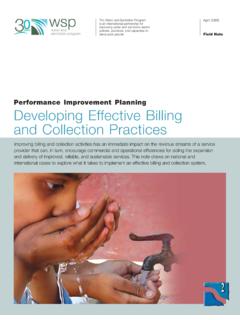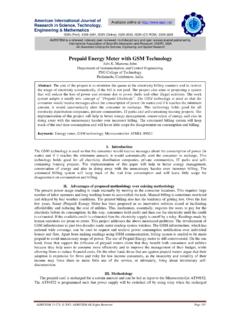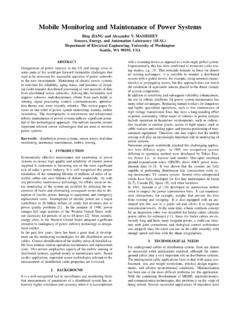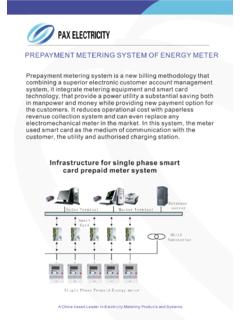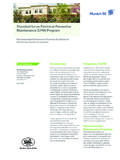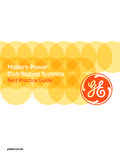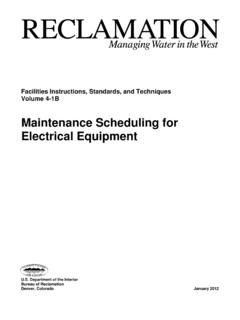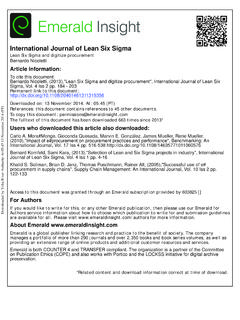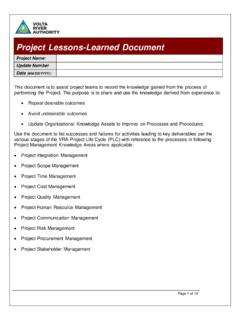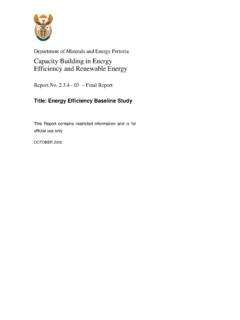Transcription of Energy Efficiency Toolkit For Manufacturers
1 Energy Efficiency ToolkitFor ManufacturersEight Proven Ways to Reduce Your Costs2 Table of ContentsIntroduction 3 Acknowledgements4 Survey Results5 Manufacturers Energy Use 7 The Eight Best Practices in Manufacturing and Companies That Use Them Increase the Efficiency of Motors and Systems9 Improve Building Lighting10 Upgrade Heating, Ventilating and Cooling11 Capture the Benefits of Utility Competition12 Empower Your Employees To Do More13 Use Water Reduction Practices14 Use the Internet15 Implement Comprehensive Facility Energyand Environmental Management16 Where To Go For Help: Resources for Reaching Your Energy Efficiency Goals 173 INTRODUCTIONE nergy prices are on the rise again and supply restraints are showing up in many parts of thecountry.
2 How Manufacturers respond to tighter Energy markets will increasingly affect theirbusiness performance and , Energy Efficiency comes naturally to Manufacturers because it is an application oftotal quality management that eliminates waste in the production process. Technologicaladvances and the application of total quality management in the workplace have spurred anextraordinary growth in manufacturing productivity over the past Energy - Efficiency Toolkit , published by the National Association of Manufacturers and itsresearch and education arm, The Manufacturing Institute, was created to help make savingenergy a part of Manufacturers and employees daily routine.
3 NAM members recently sharedtheir Energy -saving secrets, as part of a survey NAM and the institute conducted in spring than 400 Manufacturers participated in the survey, which revealed that 85 percent havemade Energy - Efficiency improvements over the past five years. Simple measures that reduceenergy use by just 10 percent can shave as much as $18 billion off Energy -consumption Toolkit features eight Energy - Efficiency success stories, as well as a guide to dozens of publicand private resources that can help your company reduce Energy waste and increase Toolkit is for you and your employees, suppliers and customers; as well as the local mediaand government officials.
4 I encourage you to distribute it among these groups. We are alsoplacing this publication on our Web site so a wide audience can access the information everyone with whom you work will lead to the exchange of great ideas for savingyour company Energy , decreasing waste and boosting your bottom J. JasinowskiVice Chairman, The Manufacturing InstitutePresident, National Association of ManufacturersFor the complete, on-line version of this Toolkit ,visit The Manufacturing Institute Web site at people helped develop this brochure, and The Manufacturing Institute and the NAM aregrateful for all their and foremost, we would like to thank over 400 companies that participated in the spring2000 survey of Manufacturers on Energy Efficiency .
5 It is their experience in saving Energy andreducing their costs that forms the basis of this are especially grateful to the companies who supplied the information in each of the bestpractices sidebars: Samsonite Corp., The Timken Company, G. H. Stenner & Co., HydeManufacturing Co., Pitney Bowes Inc., G&S Titanium, Merck & Co. and Pfizer Inc. Theirsuccess stories clearly illustrate what steps they took to save Energy and how they communicatedit to their employees and to Mark Whitenton, NAM s vice president for resources, environment and regulation;and to Barb Haig, president of Barbara Haig Communications. Both of them helped develop thecontent and organization of the survey and provided invaluable advice each step of the Paul, a professional writer and journalist in Westfield, conducted the companyinterviews and wrote most of this report.
6 He developed this publication in close association withMike Arny and Steve Olson at the Leonardo Academy in Madison, Wis. All three have animpressive understanding of Energy use and Energy markets; their insight was also want to thank Kevin Sullivan and Noah Sloss at the NAM for the layout and design andIngrid Davitt for the final edits. Bill Canis, executive director of the institute, supervised theentire project, including editorial direction and coordination with other Efficiency in ManufacturingSurvey ResultsOverview. In spring 2000, The Manufacturing Institute conducted a survey of Manufacturers togain insight on their Energy Efficiency practices.
7 Manufacturing accounts for more than 40percent of all Energy use in the United States and was responsible for 30 percent of growth in the 1990s. Understanding what Manufacturers are doing in the area ofenergy Efficiency is an important prerequisite for holding meaningful public policy discussionson America s economic report summarizes the findings of The Manufacturing Institute survey of more than the past five years, a vast majority of Manufacturers have improved the energyefficiency of their plants and offices. Even though the relative price of energyincreased only slightly during this period, large and small users alike chose to makeimprovements in a number of broad areas, namely lighting; heating, ventilating and air-conditioning systems (HVAC); and plant motors and surprisingly, Manufacturers primary motivation was the desire to save money.
8 That aside, Manufacturers acted more out of a voluntary commitment to a better environment than becauseof any regulatory requirements. While nearly 60 percent foresee electricity restructuring savingthem up to 20 percent on their utility bills, a significant number would consider taking additionalvoluntary steps, such as developing an Energy - Efficiency information campaign for for Efficiency Investments. This survey of NAM members the first in a decade was undertaken by the NAM and the institute to help Congress, the media and the general publicbetter understand current trends of Manufacturers in Energy Efficiency . Approximately 85 percentof respondents answered yes when asked, Has your company undertaken Energy -efficiencyactions in the past five years?
9 Of that 85 percent, approximately four out of five said the mostimportant reason why they had improved their facilities Energy Efficiency was to savemoney. Specifically about three-fourths made lighting- Efficiency improvements in some or all of their plants,while nearly half did so in some or all of their offices; more than half made HVAC improvements in both their plants and offices; more than half improved the Efficiency of motors and machinery in some or all of theirplants; nearly 4 in 10 trained facility managers in Energy -efficient practices; and approximately 1 in 3 benchmarked against baseline Energy users of Energy were almost as likely to have made productivity-enhancing efficiencyimprovements as large users.
10 For example, among respondents who reported annual Energy costs6between $25,000 and $50,000 a year, more than 55 percent said they had made HVAC improvements in at least some of their the Environment. Nearly 40 percent ranked voluntarily helping the environment astheir second most important reason for improving the Energy Efficiency of their emissions regulations ranked as a distant third, followed by, improvingcommunity relations and requested by customers. Additional Voluntary Environmental Steps. Energy Efficiency is just one of a number ofvoluntary pro-environmental activities engaged in by Manufacturers . More than three-fourths reported that they reduce, reuse and recycle non-regulated materials.
